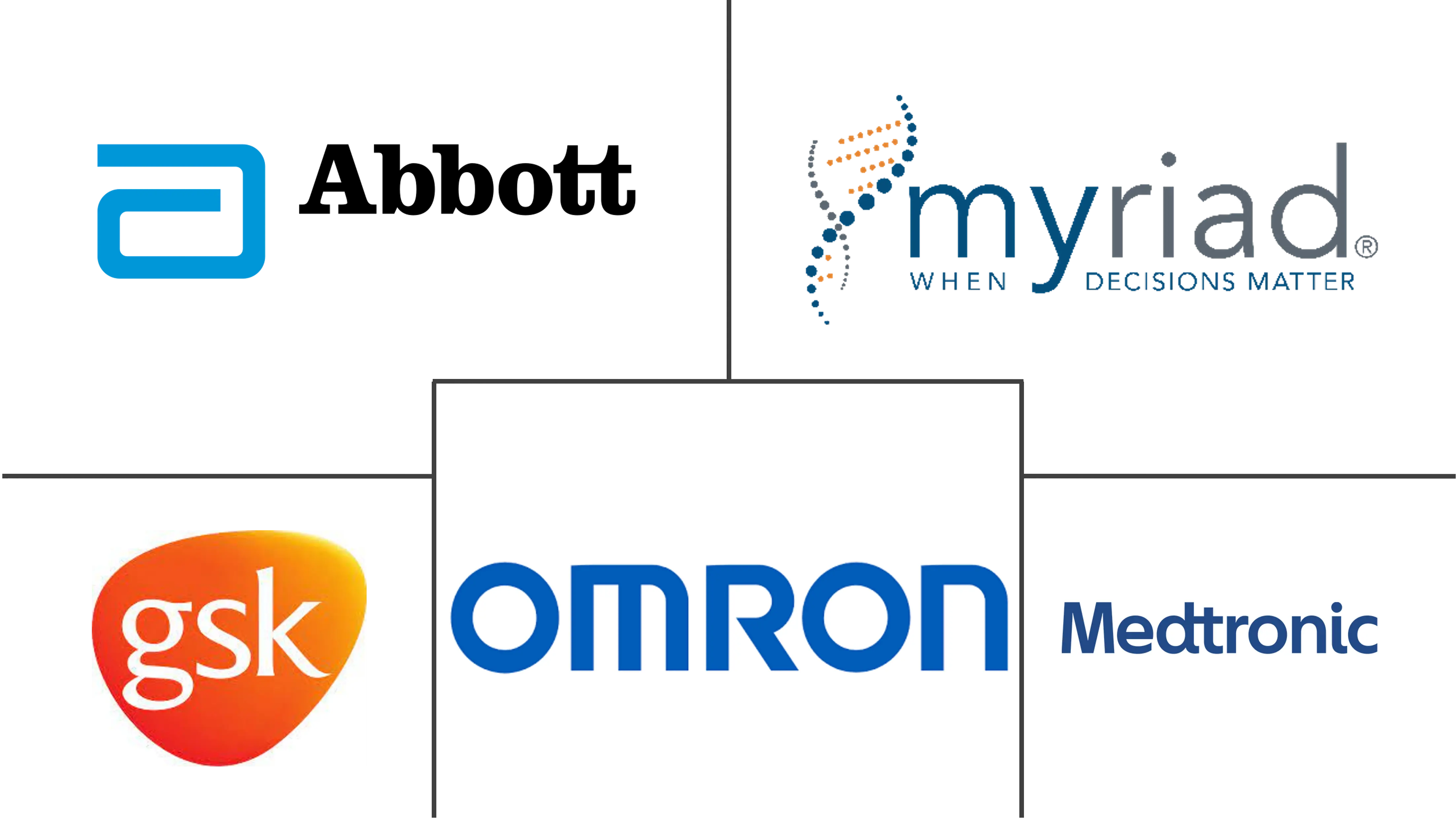Global Preventive Healthcare Technologies And Services Market Size and Share
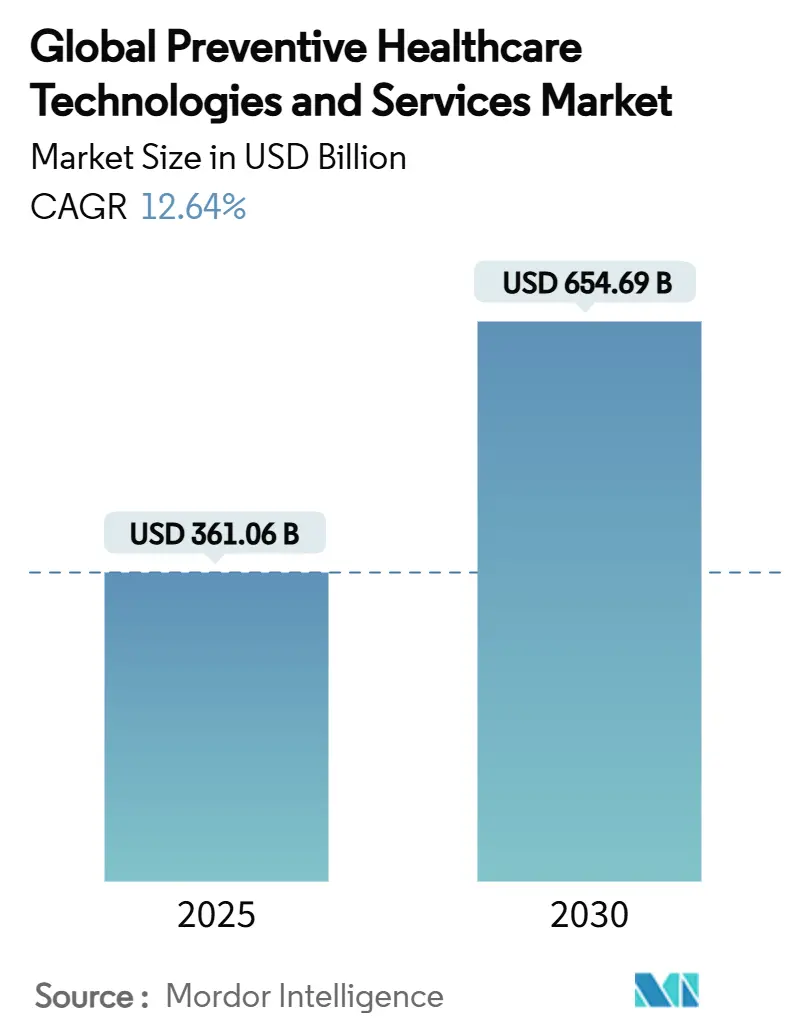
Global Preventive Healthcare Technologies And Services Market Analysis by Mordor Intelligence
The preventive health technologies and services market size is valued at USD 366.91 billion in 2025 and is projected to reach USD 665.31 billion by 2030, marking a 12.64% CAGR. Escalating chronic-disease treatment costs, rising employer spending on value-based care contracts, and the mainstreaming of AI-driven risk stratification widen the addressable base for screening devices, virtual coaching, and population-level diagnostics. North America captured 42.23% revenue share in 2024 on the back of mature reimbursement frameworks, whereas Asia-Pacific is set to expand at a 14.19% CAGR through 2030 as governments scale digital-health infrastructure and mobile-first screening programs.
Key Report Takeaways
By product and services, products commanded 65.39% of preventive health technologies and services market share in 2024, Services are projected to expand at a 13.78% CAGR between 2025-2030.
By delivery mode, in-person channels represented 63.45% of the preventive health technologies and services market size in 2024, 2Remote solutions are forecast to advance at a 14.52% CAGR to 2030.
By end user, healthcare providers led with 38.82% revenue share in 2024, Individual consumers show the fastest trajectory at a 13.92% CAGR through 2030.
By geography, North America held 42.23% of 2024 spending, Asia-Pacific is expected to post the highest regional CAGR at 14.19% to 2030.
Global Preventive Healthcare Technologies And Services Market Trends and Insights
Driver Impact Analysis
| Driver | (~) % Impact on CAGR Forecast | Geographic Relevance | Impact Timeline |
|---|---|---|---|
| Rising chronic-disease burden fuelling proactive health screening | +2.1% | Global, with highest impact in North America and Europe | Medium term (2-4 years) |
| Consumer adoption of wearable monitoring devices | +1.8% | Global, led by North America and Asia-Pacific | Short term (≤ 2 years) |
| AI-driven predictive analytics enabling risk stratification | +1.5% | North America and Europe core, expanding to Asia-Pacific | Medium term (2-4 years) |
| Government-funded population screening & vaccination programs | +1.2% | Europe and Asia-Pacific core, spill-over to emerging markets | Long term (≥ 4 years) |
| Direct-to-consumer genomic testing price collapse | +1.0% | North America and Europe primary, emerging in Asia-Pacific | Short term (≤ 2 years) |
| Employer-sponsored wellness incentives tied to insurance premiums | +0.8% | North America and Europe primary, expanding to Asia-Pacific | Medium term (2-4 years) |
| Source: Mordor Intelligence | |||
Rising Chronic-Disease Burden Fuelling Proactive Health Screening
Employer medical outlays climbed 7-9% per year in 2024, while diabetes costs alone reached USD 327 billion in the United States, prompting payers and providers to pivot from episodic care to early-detection programs. AI-enabled stratification flags high-risk individuals months before symptom onset, lowering emergency-department use by 20-30% in corporate cohorts with comprehensive screening benefits. Value-based care contracts covering 4.7 million Optum patients underscore the economic case for prevention, as health systems earn shared savings for keeping populations healthier. Aging demographics and lifestyle-driven morbidity amplify demand for screening kits, mobile diagnostics, and virtual nutrition counseling across every segment of the preventive health technologies and services market. Multinational employers are embedding these offerings into benefits packages to mitigate absenteeism and retain talent in tight labor markets.
Consumer Adoption of Wearable Monitoring Devices
Continuous glucose monitors, smartwatches with ECG, and patch-based blood-pressure sensors have shifted from wellness gadgets to reimbursable medical devices as payers recognize their clinical utility[1]Source: Healthcare Digital, “Healthcare Cybersecurity Investments 2025,” healthcare.digital . Apple’s February 2025 expansion of the Apple Heart & Movement Study positions its watch ecosystem as a large-scale research platform, while Google’s MedLM conversational agent provides real-time coaching based on streaming biometric data. Coverage expansions by Medicare and Medicaid for remote patient monitoring drove a surge in physician-initiated wearables prescriptions, turning personal devices into clinical endpoints. Patients share biometric feeds in exchange for personalized risk reports, though 40% of Europeans remain cautious amid GDPR-heightened privacy expectations. Integration of wearable streams with EHRs enriches longitudinal datasets, enhancing diagnostic precision and fueling AI algorithm development.
Government-Funded Population Screening & Vaccination Programs
Public-health agencies deploy cloud platforms to scale screening beyond brick-and-mortar capacity, as seen in the CDC’s national immunization registries and the U.K.’s digital health-passport rollout. Brazil’s UBS+Digital initiative resolved 85% of teleconsults remotely while training 342 clinicians, showcasing digital triage’s cost-effectiveness in constrained settings. Policymakers allocate funds to AI-driven analytics that mine registries and genomics data to pinpoint at-risk citizens, optimizing resource allocation for colonoscopy, mammography, and vaccination drives. These programs standardize procurement criteria, anchoring multiyear demand for screening kits, imaging algorithms, and secure data exchanges in the preventive health technologies and services market. Regulatory clarity around data sharing accelerates vendor onboarding while fostering regional interoperability goals.
Employer-Sponsored Wellness Incentives Tied to Insurance Premiums
U.S. companies that coupled biometric screenings with premium differentials recorded 21% cuts in annual plan costs, validating the ROI of proactive engagement strategies. Transcarent’s USD 621 million acquisition of Accolade reinforces the shift toward integrated platforms that bundle navigation, coaching, and virtual primary care for self-insured employers. Digital risk assessments, lifestyle-coaching apps, and home test kits help employees modify behaviors, lowering ER visits and boosting productivity. Aggregated workplace data feed predictive models that refine population-level interventions, creating a feedback loop of cost savings and healthier employees. As labor markets tighten, preventive benefits have become a differentiator in recruitment and retention packages across knowledge-based industries.
Restraint Impact Analysis
| Restraint | (~) % Impact on CAGR Forecast | Geographic Relevance | Impact Timeline |
|---|---|---|---|
| Data-privacy & cybersecurity concerns | -1.5% | Global, with highest impact in Europe due to GDPR and AI Act | Short term (≤ 2 years) |
| Reimbursement gaps for preventive services | -0.9% | North America and emerging markets primarily | Medium term (2-4 years) |
| Algorithmic bias in risk-prediction models | -0.7% | Global, with regulatory focus in North America and Europe | Medium term (2-4 years) |
| Low digital-literacy in aging populations | -0.6% | Global, with highest impact in developed markets | Long term (≥ 4 years) |
| Source: Mordor Intelligence | |||
Data-Privacy & Cybersecurity Concerns
Europe’s AI Act, in effect since August 2024, mandates algorithmic transparency and bias monitoring, increasing compliance overhead for vendors rolling out preventive health algorithms[2]Source: European Commission, “EU AI Act Text,” europa.eu . High-profile breaches continue to dampen public trust; 40% of surveyed patients hesitate to share data with digital platforms even when benefits are clear. Each node—from wearable OEMs to EHR vendors—presents an attack surface, compelling organizations to balance openness for analytics with zero-trust architectures. Implementation delays and higher insurance premiums for cybersecurity coverage erode margins for smaller digital-health providers.
Reimbursement Gaps for Preventive Services
Advanced genetic panels, multi-cancer early-detection assays, and app-based behavioral therapeutics often lack CPT codes or evidentiary standards required for broad payer adoption, forcing direct-pay models that limit volumes. The lag between innovation and coverage updates injects revenue uncertainty that deters venture backing and slows provider uptake despite favorable clinical outcomes. Fragmented payment systems across Medicaid, commercial, and self-insured plans complicate scaling strategies for startups, especially in emerging markets where insurance penetration is low. Providers hesitate to prescribe unreimbursed tools, curbing real-world data generation necessary for future approval cycles. These gaps shave nearly 0.9 percentage points off the preventive health technologies and services market CAGR forecast.
Segment Analysis
By Product and Services: Services Surge as Value-Based Care Scales
Products retained the largest slice of the preventive health technologies and services market size at USD 241.0 billion in 2024, buoyed by recurring sensor sales and app subscriptions. However, services are forecast to climb 13.78% annually, propelled by capitated contracts that reward prevention over acute interventions. Health-risk assessments, lifestyle coaching, and chronic-disease management bundles have proliferated as providers align to shared-savings models that monetize improved outcomes.
Tele-preventive consultations top the growth charts, aided by policy parity and employer adoption for hybrid workforces. Disease-specific management programs—diabetes, hypertension, obesity—anchor sticky revenue via continuous data feeds and algorithmic titration protocols that reduce hospitalization events. Lifestyle-coaching solutions appeal to large enterprises that document double-digit reductions in health-plan liabilities after rolling out comprehensive wellness schemes.
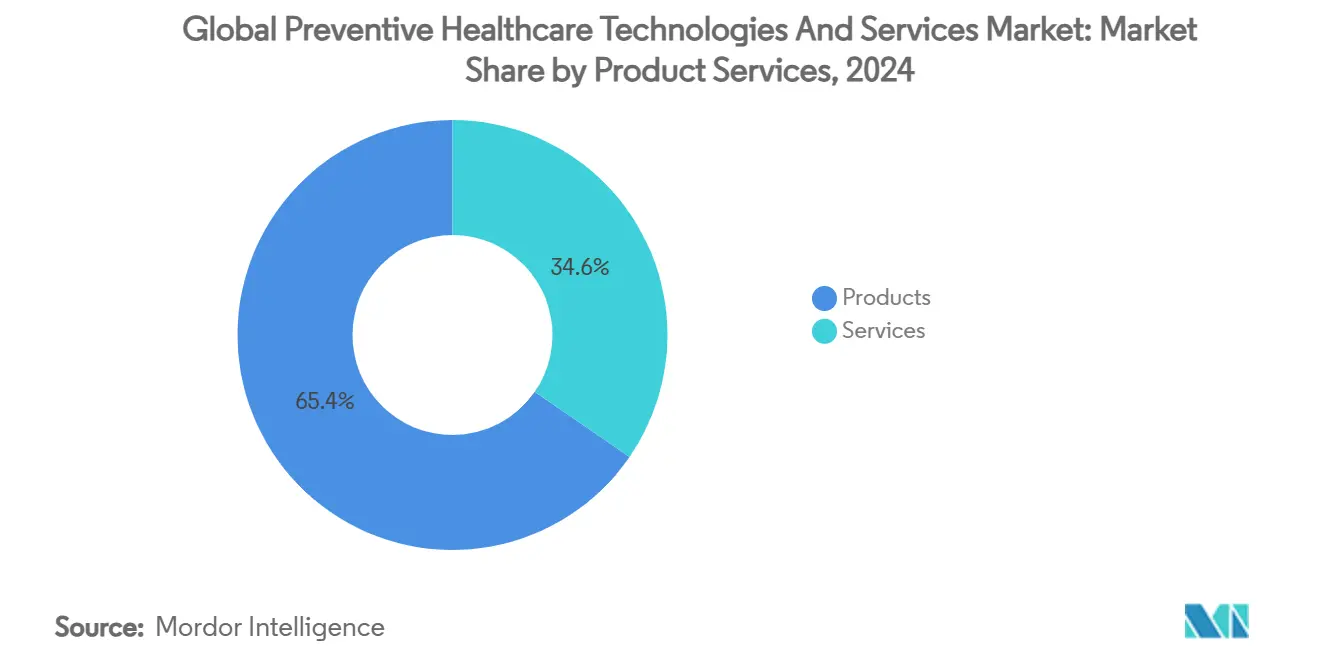
By Delivery Mode: Remote Platforms Re-Engineer Access
In-person modalities accounted for 63.45% of preventive health technologies and services market share in 2024 thanks to imaging, lab draws, and vaccinations requiring physical presence. Remote care will outpace brick-and-mortar, expanding at a 14.52% CAGR as reimbursement parity, workforce shortages, and patient convenience reshape utilization. Teladoc’s USD 65 million Catapult Health buyout highlights strategic bets on at-home diagnostics bundled with virtual follow-ups for early cardio-metabolic detection.
Brazil’s UBS+Digital experience confirmed 85% issue resolution through teleconsults, proving efficacy in resource-strained geographies. Yet digital-health-literacy gaps remain: older adults scored an average 21.45 on the eHealth Literacy Scale versus the 32-point proficiency benchmark, underscoring the need for onboarding support. Integrated platforms stitch wearables, chatbots, and lab logistics into seamless user journeys, cutting friction that once deterred remote adoption.
By End User: Consumers Become Active Buyers
Healthcare providers dominated spending with 38.82% of 2024 revenues, leveraging institutional budgets to procure integrated preventive suites across primary care, imaging, and virtual monitoring. Individual consumers present the fastest runway at a 13.92% CAGR as direct-to-consumer testing hits mainstream awareness and price points fall.
Employers channel procurement power to negotiate comprehensive wellness bundles, further stimulating vendor scale and data-network effects. Payers and insurers expand value-based constructs that shift risk and rewards toward preventive performance, influencing provider toolkits and member-engagement features. Public-health agencies deploy screening tech across national registries, standardizing procurement and catalyzing vendor-certification pathways.
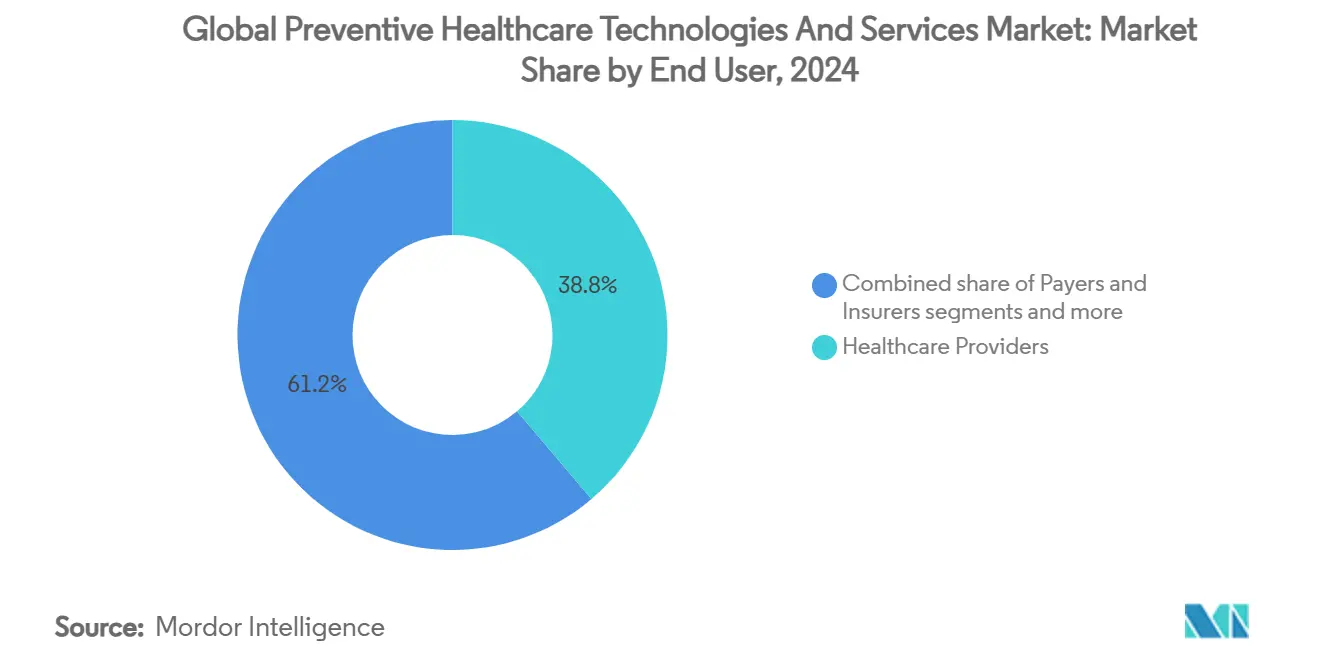
Note: Segment shares of all individual segments available upon report purchase
Geography Analysis
North America led spending with a 42.23% stake in 2024, fueled by Medicare reimbursement for remote monitoring, employer wellness incentives, and robust venture-funding pipelines. Integration of wearables with EHRs and established HIPAA frameworks eases data interoperability, shortening deployment cycles for AI-supported preventive platforms. Market headwinds include reimbursement gaps for emerging genomic assays and rising cybersecurity-insurance premiums that inflate provider overhead.
Asia-Pacific registers the highest growth at a 14.19% CAGR, buoyed by smartphone ubiquity, large-scale disease-burden pressures, and supportive government e-health blueprints. China’s Healthy China 2030 and India’s Ayushman Bharat Digital Mission accelerate investments in cloud-based registries and AI triage bots, catalyzing preventive health technologies and services market adoption. Mobile first-time users leapfrog legacy care pathways, employing chat-based risk assessments and e-pharmacy logistics to bridge rural access gaps.
Europe grows steadily on the strength of universal-coverage models and policy mandates that embed screening and vaccination targets into national budgets. The European Health Data Space standardizes cross-border data interoperability, enabling scale economics for predictive-analytics vendors. EU AI Act compliance raises upfront development costs but offers long-term regulatory certainty, improving investor confidence in preventive-health solutions. South America, the Middle East, and Africa contribute modest shares today yet represent attractive white space, with pilots such as Brazil’s UBS+Digital proving tele-prevention can thrive even amid infrastructure constraints.
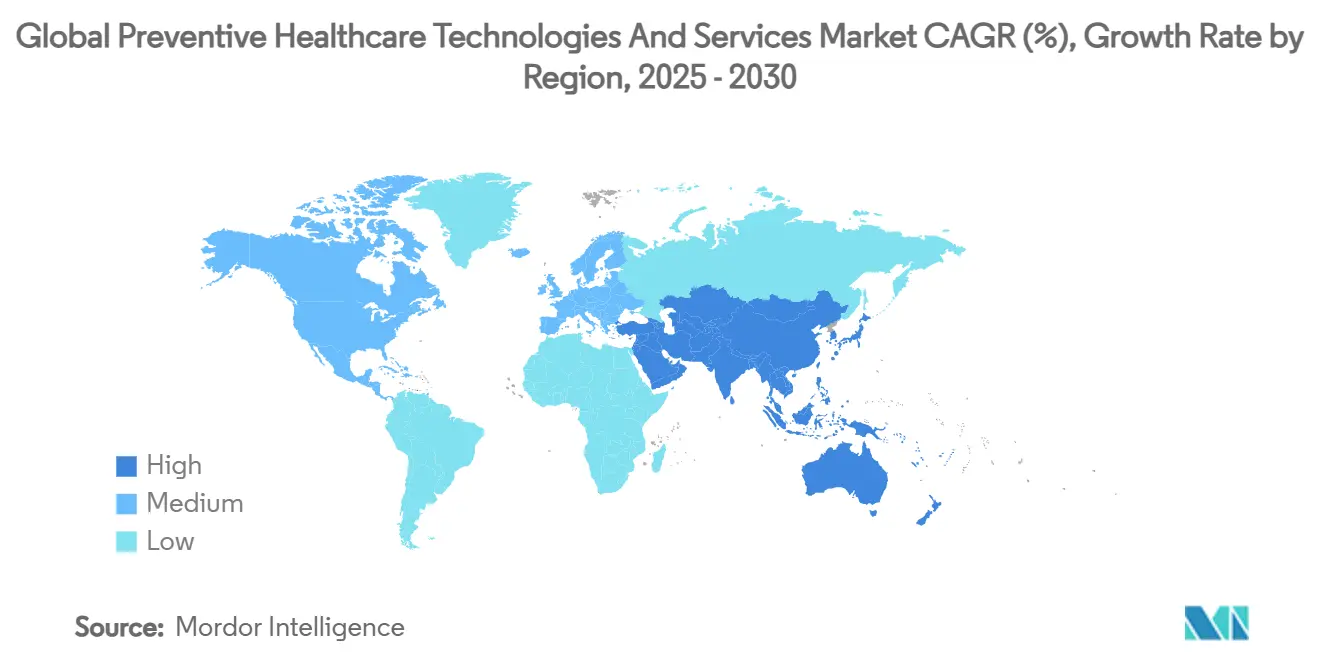
Competitive Landscape
Market fragmentation persists as technology majors, medtech incumbents, and venture-backed disruptors converge on overlapping value pools. Philips filed 594 patents in 2024 and invested EUR 1.7 billion in R&D, underlining a hardware-plus-AI strategy that spans image-guided therapy and handheld ultrasound. Apple widens its clinical-research footprint via watch-based studies while Alphabet layers large-language-model coaching into Android-health services. Convergence sparks consolidation: Transcarent acquired Accolade for USD 621 million to bundle navigation, advocacy, and virtual primary care under one consumer-centric roof. Teladoc folded Catapult Health into its chronic-care portfolio for USD 65 million, betting on at-home diagnostics to deepen engagement.
White space opportunities arise in algorithmic-bias mitigation, culturally adapted coaching, and low-cost hardware for emerging markets where traditional OEM prices remain prohibitive. Startups focusing on multi-cancer early detection, AI triage APIs, and workplace-wellness gamification secure funding as employers chase measurable ROI. Regulatory competence becomes a competitive moat; vendors that certify algorithms under the EU AI Act and HIPAA simultaneously gain preferred-supplier status with multinational providers. Data-network effects favor platforms that integrate wearable telemetry, claims data, and genomic profiles into unified risk scores, locking in users through superior predictive accuracy.
Mature players diversify revenue streams toward subscription analytics and care-coordination SaaS layers to counter hardware commoditization. Partner ecosystems linking insurers, device makers, and telehealth operators accelerate go-to-market scale, reflecting the platformization trend sweeping the preventive health technologies and services market.
Global Preventive Healthcare Technologies And Services Industry Leaders
-
GlaxoSmithKline
-
Myriad Genetics
-
Omron Healthcare
-
Abbott Laboratories
-
Trapollo
- *Disclaimer: Major Players sorted in no particular order
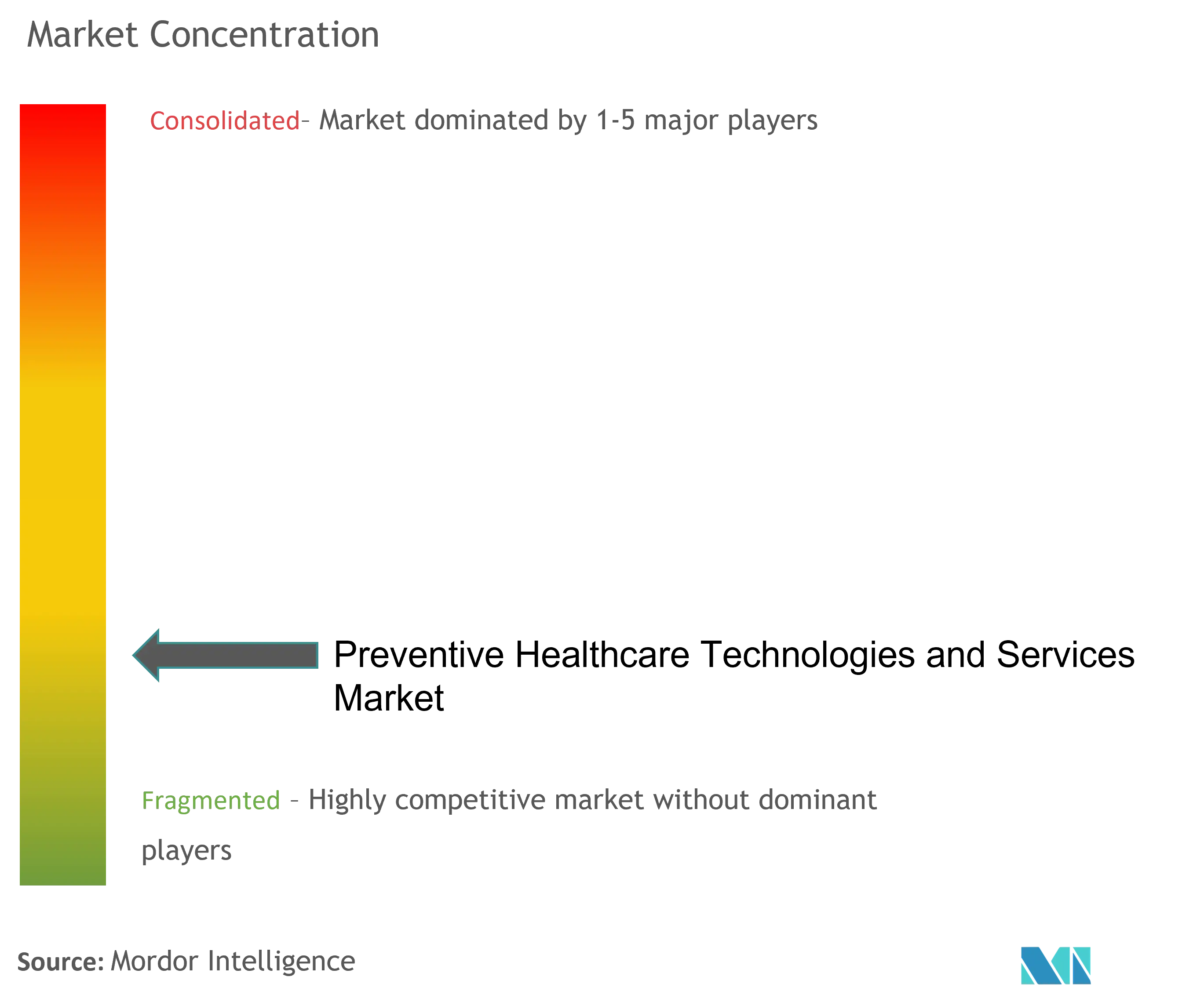
Recent Industry Developments
- February 2025: Teladoc Health bought Catapult Health for USD 65 million to extend at-home diagnostics for diabetes and hypertension
- January 2025: Transcarent closed its USD 621 million Accolade acquisition, integrating AI WayFinding, advocacy, and virtual primary care
Global Preventive Healthcare Technologies And Services Market Report Scope
As per the scope of the report, preventive healthcare is a proactive approach to addressing healthcare concerns. It attempts to deal with issues before an emergency room visit is required or an illness has progressed past the point of effective treatment. Preventive healthcare and technologies and services comprise all technological products and services that help in the prevention and early diagnosis of diseases. The preventive healthcare technologies and services market is segmented by type, application, and geography. By type, the market is segmented into early detection and screening, vaccines, chronic disease management, and advanced technologies to reduce errors. By application, the market is segmented into hospitals, clinics, and others. For each segment, the market size is provided in terms of value (USD).
| Products | Screening & Diagnostic Devices |
| Wearable Health Trackers | |
| Genetic-Testing Kits | |
| Mobile Health Apps | |
| Vaccination Platforms | |
| Services | Health-Risk Assessment |
| Corporate Wellness Programs | |
| Lifestyle Coaching | |
| Disease-Management Services | |
| Tele-preventive Consultations |
| In-Person |
| Remote / Virtual |
| Healthcare Providers |
| Employers |
| Payers & Insurers |
| Individuals |
| Government / Public-Health Agencies |
| North America | United States |
| Canada | |
| Mexico | |
| Europe | Germany |
| United Kingdom | |
| France | |
| Italy | |
| Spain | |
| Rest of Europe | |
| Asia-Pacific | China |
| India | |
| Japan | |
| South Korea | |
| Australia | |
| Rest of Asia-Pacific | |
| South America | Brazil |
| Argentina | |
| Rest of South America | |
| Middle East and Africa | GCC |
| South Africa | |
| Rest of Middle East and Africa |
| By Product & Services | Products | Screening & Diagnostic Devices |
| Wearable Health Trackers | ||
| Genetic-Testing Kits | ||
| Mobile Health Apps | ||
| Vaccination Platforms | ||
| Services | Health-Risk Assessment | |
| Corporate Wellness Programs | ||
| Lifestyle Coaching | ||
| Disease-Management Services | ||
| Tele-preventive Consultations | ||
| By Delivery Mode | In-Person | |
| Remote / Virtual | ||
| By End User | Healthcare Providers | |
| Employers | ||
| Payers & Insurers | ||
| Individuals | ||
| Government / Public-Health Agencies | ||
| By Geography | North America | United States |
| Canada | ||
| Mexico | ||
| Europe | Germany | |
| United Kingdom | ||
| France | ||
| Italy | ||
| Spain | ||
| Rest of Europe | ||
| Asia-Pacific | China | |
| India | ||
| Japan | ||
| South Korea | ||
| Australia | ||
| Rest of Asia-Pacific | ||
| South America | Brazil | |
| Argentina | ||
| Rest of South America | ||
| Middle East and Africa | GCC | |
| South Africa | ||
| Rest of Middle East and Africa | ||
Key Questions Answered in the Report
How large is global spending on preventive technologies in 2025?
The preventive health technologies and services market size stands at USD 366.91 billion in 2025 and is forecast to reach USD 665.31 billion by 2030.
What annual growth rate is projected for the sector?
Market value is expected to expand at a 12.64% CAGR from 2025 to 2030.
Which region is expanding fastest?
Asia-Pacific records the highest regional CAGR at 14.19% through 2030, driven by government e-health programs and rising chronic-disease prevalence.
Who are the primary buyers of preventive solutions?
Healthcare providers command the largest revenue share, but individual consumers are the fastest-growing end-user group at a 13.92% CAGR.
What is the top restraint facing vendors?
Data-privacy and cybersecurity concerns reduce expected CAGR by 1.5 percentage points as compliance costs and breach anxiety slow adoption.
Which delivery model is gaining ground?
Remote and virtual care is forecast to expand 14.52% annually, outpacing in-person services due to reimbursement parity and consumer demand for convenience.
Page last updated on:
